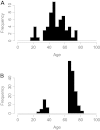High-dimensional analysis of the aging immune system: verification of age-associated differences in immune signaling responses in healthy donors
- PMID: 24952610
- PMCID: PMC4229969
- DOI: 10.1186/1479-5876-12-178
High-dimensional analysis of the aging immune system: verification of age-associated differences in immune signaling responses in healthy donors
Abstract
Background: Single-cell network profiling (SCNP) is a multiparametric flow cytometry-based approach that simultaneously measures evoked signaling in multiple cell subsets. Previously, using the SCNP approach, age-associated immune signaling responses were identified in a cohort of 60 healthy donors.
Methods: In the current study, a high-dimensional analysis of intracellular signaling was performed by measuring 24 signaling nodes in 7 distinct immune cell subsets within PBMCs in an independent cohort of 174 healthy donors [144 elderly (>65 yrs); 30 young (25-40 yrs)].
Results: Associations between age and 9 immune signaling responses identified in the previously published 60 donor cohort were confirmed in the current study. Furthermore, within the current study cohort, 48 additional immune signaling responses differed significantly between young and elderly donors. These associations spanned all profiled modulators and immune cell subsets.
Conclusions: These results demonstrate that SCNP, a systems-based approach, can capture the complexity of the cellular mechanisms underlying immunological aging. Further, the confirmation of age associations in an independent donor cohort supports the use of SCNP as a tool for identifying reproducible predictive biomarkers in areas such as vaccine response and response to cancer immunotherapies.
Figures




Similar articles
-
Single-cell network profiling of peripheral blood mononuclear cells from healthy donors reveals age- and race-associated differences in immune signaling pathway activation.J Immunol. 2012 Feb 15;188(4):1717-25. doi: 10.4049/jimmunol.1102514. Epub 2012 Jan 13. J Immunol. 2012. PMID: 22246624 Free PMC article.
-
Racial differences in B cell receptor signaling pathway activation.J Transl Med. 2012 Jun 6;10:113. doi: 10.1186/1479-5876-10-113. J Transl Med. 2012. PMID: 22672557 Free PMC article.
-
Inter-donor variation in cell subset specific immune signaling responses in healthy individuals.Am J Clin Exp Immunol. 2012 Apr 24;1(1):1-11. Print 2012. Am J Clin Exp Immunol. 2012. PMID: 23885311 Free PMC article.
-
Single-cell network profiling (SCNP) by flow cytometry in autoimmune disease.Autoimmunity. 2010 Nov;43(7):550-9. doi: 10.3109/08916931003674774. Autoimmunity. 2010. PMID: 20482423 Review.
-
Senescent remodeling of the immune system and its contribution to the predisposition of the elderly to infections.Chin Med J (Engl). 2012 Sep;125(18):3325-31. Chin Med J (Engl). 2012. PMID: 22964331 Review.
Cited by
-
Immune monitoring technology primer: Single Cell Network Profiling (SCNP).J Immunother Cancer. 2015 Aug 18;3:34. doi: 10.1186/s40425-015-0075-z. eCollection 2015. J Immunother Cancer. 2015. PMID: 26288736 Free PMC article. No abstract available.
-
Defective Signaling in the JAK-STAT Pathway Tracks with Chronic Inflammation and Cardiovascular Risk in Aging Humans.Cell Syst. 2016 Oct 26;3(4):374-384.e4. doi: 10.1016/j.cels.2016.09.009. Epub 2016 Oct 13. Cell Syst. 2016. PMID: 27746093 Free PMC article.
-
Differences in Proinflammatory Cytokines and Monocyte Subtypes in Older as Compared With Younger Kidney Transplant Recipients.Transplant Direct. 2018 Feb 14;4(3):e348. doi: 10.1097/TXD.0000000000000762. eCollection 2018 Mar. Transplant Direct. 2018. PMID: 29707619 Free PMC article.
-
Large-Scale and Comprehensive Immune Profiling and Functional Analysis of Normal Human Aging.PLoS One. 2015 Jul 21;10(7):e0133627. doi: 10.1371/journal.pone.0133627. eCollection 2015. PLoS One. 2015. PMID: 26197454 Free PMC article.
-
Investigating population-level immunosenescence: From bench to bedside.Front Immunol. 2022 Aug 17;13:949928. doi: 10.3389/fimmu.2022.949928. eCollection 2022. Front Immunol. 2022. PMID: 36059504 Free PMC article. Review.
References
-
- Boraschi D, Aguado MT, Dutel C, Goronzy J, Louis J, Grubeck-Loebenstein B, Rappuoli R, Del Giudice G. The gracefully aging immune system. Sci Transl Med. 2013;5:185ps188. - PubMed
MeSH terms
LinkOut - more resources
Full Text Sources
Other Literature Sources
Medical

